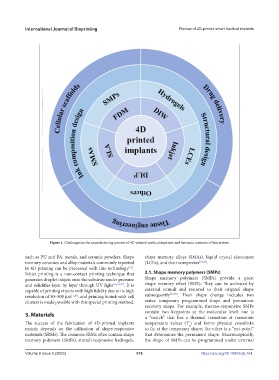Page 324 - IJB-9-5
P. 324
International Journal of Bioprinting Review of 4D-printed smart medical implants
Figure 1. Challenges in the manufacturing process of 4D-printed medical implants and the main contents of this review.
such as PU and PA, metals, and ceramic powders. Shape shape memory alloys (SMAs), liquid crystal elastomers
memory ceramics and alloy materials commonly reported (LCEs), and their composites [22,23] .
in 4D printing can be processed with this technology .
[21]
Inkjet printing is a non-contact printing technique that 3.1. Shape memory polymers (SMPs)
generates droplet inkjets onto the substrate under pressure Shape memory polymers (SMPs) provide a great
and solidifies layer by layer through UV light [15,19,22] . It is shape memory effect (SME). They can be activated by
capable of printing objects with high fidelity due to its high external stimuli and restored to their original shape
resolution of 50–500 mm [1,20] , and printing bioink with cell subsequently [24,25] . Their shape change includes two
clusters is made possible with this special printing method. states: temporary programmed shape and permanent
recovery shape. For example, thermo-responsive SMPs
3. Materials contain two keypoints at the molecular level; one is
a “switch” that has a thermal transition at transition
The success of the fabrication of 4D-printed implants temperature values (T ) and forms physical crosslinks
g
mainly depends on the utilization of shape-responsive to fix at the temporary shape; the other is a “net-point”
materials (SRMs). The common SRMs often contain shape that determines the permanent shape. Macroscopically,
memory polymers (SMPs), stimuli-responsive hydrogels, the shape of SMPs can be programmed under external
Volume 9 Issue 5 (2023) 316 https://doi.org/10.18063/ijb.764

